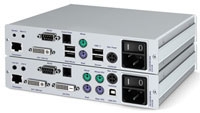KVM technology
Now that entire workflows within the broadcast industry are becoming file-based, broadcasting is turning into a profession of data management. Existing tapes must be digitized. New data from recording, editing, post processing, formatting and storing needs to be handled at distributed workstations. All of these different tasks demand an ever-increasing number of PCs and servers. Each computer requires a keyboard, monitor and mouse. This limits space and creates clutter, noise, heat, health and technical issues. Most importantly, it increases power consumption and costs.
How do technical broadcasters handle these negative elements? How do they increase the efficiency of their staff, while maintaining the effectiveness of computers? A qualified solution for streamlining processes is the implementation of KVM technology.
What is KVM technology?

KVM is a piece of hardware. Originally, the acronym KVM described a technology for extending and switching a computer's keyboard, video and mouse signals. Nowadays, KVM switches, extends and transmits transparently many more signals: different video types, bidirectional audio, RS-232 and USB. Compared with network operation, KVM products establish a 1:1 and not a data connection to the computers.
Three main categories of KVM hardware improve the working environment of employees and computers:
- KVM extenders: separate computer and user;
- KVM switches: operate multiple computers and platforms with only one keyboard, video and mouse; and
- KVM matrix switches: operate multiple computers from a distance. They combine the functionalities and advantages of extenders and switches in one system.
KVM technology delivers immediate benefits. (See Table 1.)
Feature Benefit Space
The professional video industry's #1 source for news, trends and product and tech information. Sign up below.
- Fewer peripherals such as keyboard, monitor and mouse devices at the desk
Safety and security
- Valuable computers kept cool, safe and access-protected in central engineering rooms
- Access-protected applications in busy public areas
Technology
- No software
- Use of computer's standard interfaces, even on different operating systems
- Use of infrastructural cables
- Easy access for maintenance staff
Economy
- Increased computer efficiency
- Reduced acquisition costs
- Savings on primary and secondary energy
- Reduced IT TCO
Human resources
- Better ergonomics and improved job satisfaction
- Free working space, allowing for more staff in the same space
Table 1. KVM technology delivers immediate benefits.
How do KVM extenders work?
Restrictions on the cable lengths cause difficulties when extending the distance between computer and user. Overcoming these distances requires an active amplifier such as a KVM extender. Such an extender comprises a compact transmitter and receiver. The extender's transmission distance varies between 10m and 10,000m depending on the KVM device in use.
Thanks to KVM, the computer can now be stored in a safe and environmentally controlled room. Here, all external interfaces are connected to a KVM transmitter. The local ports at the transmitter allow local computer access.
At the remote user station, users can connect all peripheral hardware to the KVM receiver, simply via plug-and-play keyboard, single or multiple monitors, mouse, microphone, speakers, touchpad, printer, camera, scanner or any other device needed in broadcast or post production.
The transmitter and receiver can be linked over infrastructural cables — either standard UTP or STP copper cable (Cat, up to 300m) or fiber optics (single-mode or multimode, up to 10,000m). The screen resolution and distance to be bridged are determining factors in choosing the extender cables.
How do KVM switches work?
The stand-alone devices allow a user to access a pool of computers even with different platforms over a console consisting of only one keyboard, video (display) and mouse. KVM switches access between two to eight computers, cascaded up to 256. As is standard in KVM technology, the switches are only connected to external computer interfaces. Switching between computers is carried out over a keyboard hotkey, push button or external device.
Cable skew issues
The video signal is the most visible and, therefore, determining component for KVM extension or switching. The accompanying signals only need a small bandwidth and are not highly sensitive.
Because KVM technology is based on Cat cables, people often assume that signals are digitally transmitted. However, the signal is still analog. Cat cables comprise a group of twisted pairs. Transmitting KVM as component RGB over Cat can result in color misregistration as a result of small differences in the length of each pair.
KVM products for analog video support resolutions up to WUXGA (1920 × 1200) with a bandwidth of 250MHz, while DVI devices display WQXGA (2560 × 1600) at 330MHz. It is important to know that a KVM product supports display data channel (DDC), which communicates information between the monitor and the graphics card. Another aspect to consider is that digital video signals may require a reduced frame rate, so you have to ensure the KVM product you want to use displays images smoothly.
KVM benefits and beyond
There is one aspect that the huge variety of KVM products has in common: The devices are easy to install and can be operated immediately. The components of high-quality KVM extenders can be assembled individually and are specially tailored to the user's requirements without any extra costs. In addition to their comprehensive hardware, KVM products offer numerous features such as extensive user rights, network access, authentication, preventive monitoring, and event reporting that improve both operation and safety yet still comply with any internal IT policies.
Annette Haebel is technical editor at Guntermann & Drunck.
